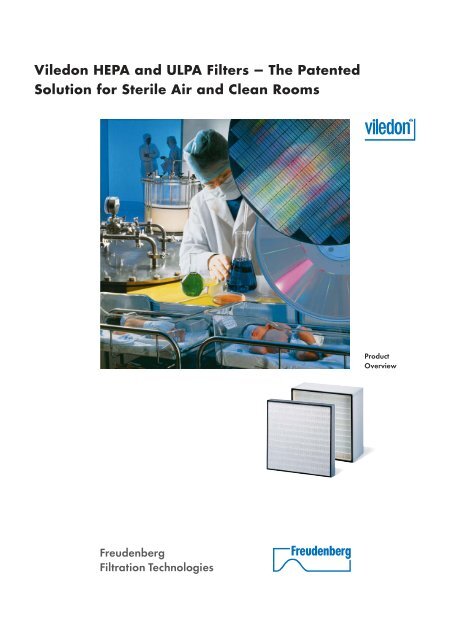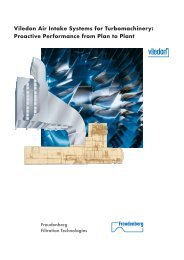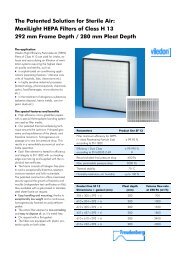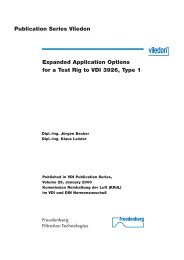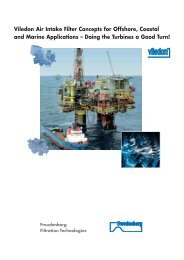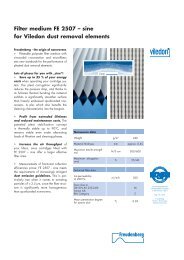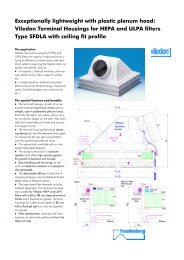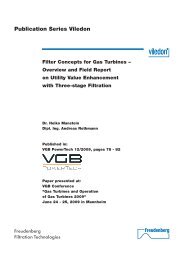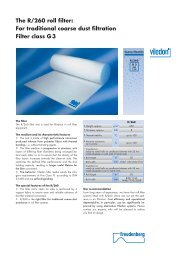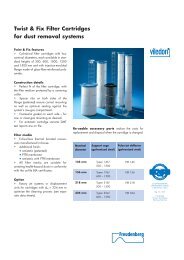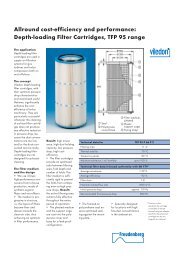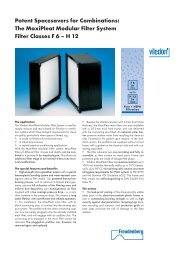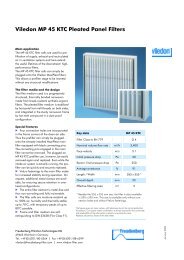Viledon HEPA and ULPA Filters - Freudenberg Filtration Technologies
Viledon HEPA and ULPA Filters - Freudenberg Filtration Technologies
Viledon HEPA and ULPA Filters - Freudenberg Filtration Technologies
Create successful ePaper yourself
Turn your PDF publications into a flip-book with our unique Google optimized e-Paper software.
<strong>Viledon</strong> <strong>HEPA</strong> <strong>and</strong> <strong>ULPA</strong> <strong>Filters</strong> – The Patented<br />
Solution for Sterile Air <strong>and</strong> Clean Rooms<br />
Product<br />
Overview
In a class of their own for technology <strong>and</strong><br />
performance<br />
While the performance qualities of air filters in<br />
Classes F 5 to F 9 are assessed in terms of the<br />
efficiency for the particle size 0.4 µm, averaged<br />
over the dust loading, to EN 779, <strong>HEPA</strong> <strong>and</strong><br />
<strong>ULPA</strong> filters from Class H10 upwards are classified<br />
in terms of their particle-size-referenced minimum<br />
efficiency in new condition as laid down by<br />
EN 1822. This classification by minimum collection<br />
efficiencies is based on minimum curves describing<br />
the arrestance characteristics of <strong>HEPA</strong><br />
<strong>and</strong> <strong>ULPA</strong> filter media with defined particle sizes<br />
at nominal media velocity.<br />
Fractional efficiency T(x) [%]<br />
Diffusion<br />
Efficiency<br />
minimum<br />
(x = MPPS)<br />
MPPS<br />
Inertia<br />
The particle size at which the medium exhibits the<br />
lowest collection efficiency is called the Most<br />
Penetrating Particle Size (MPPS). The typical parabolic<br />
shape of these minimum curves shows that<br />
particles both larger <strong>and</strong> smaller than the MPPS<br />
are arrested more effectively (see graph on the<br />
right).<br />
The European st<strong>and</strong>ard EN1822 replaces various<br />
national st<strong>and</strong>ards like DIN 24183, DIN 24184,<br />
BS 3928 <strong>and</strong> AFNOR 44013: when EN 1822<br />
was drawn up, it was based on DIN 24183,<br />
<strong>and</strong> is largely identical to it.<br />
EN 1822 distinguishes between <strong>HEPA</strong> filters<br />
(High-Efficiency Particulate Air <strong>Filters</strong>) up to Class<br />
H14, <strong>and</strong> <strong>ULPA</strong> filters (Ultra Low Penetration Air<br />
<strong>Filters</strong>), from Class U15 upwards. The table below<br />
shows previous classification systems for<br />
<strong>HEPA</strong> <strong>and</strong> <strong>ULPA</strong> filters in comparison with EN<br />
1822 <strong>and</strong> the US Military St<strong>and</strong>ard.<br />
0.01 0.02 0.05 0.1 0.2 0.3 0.5 1 2 3<br />
Particle diameter [ m]<br />
MPPS: Most Penetrating Particle Size<br />
Efficiency minimum<br />
Minimum curve for an H13 filter medium<br />
Elaborate in every detail ...<br />
<strong>Viledon</strong> <strong>HEPA</strong> <strong>and</strong> <strong>ULPA</strong> filters are manufactured<br />
using our patented thermal embossing process<br />
or the minipleating technique. In the minipleating<br />
technique, thin hotmelt threads serve for fixing<br />
<strong>and</strong> spacing the pleats. It is used for pleat<br />
depths of up to 100 mm.<br />
In the thermal embossing process, a complementary<br />
pair of cylinders simultaneously embosses<br />
conical dimples <strong>and</strong> the subsequent pleat<br />
tips into a heated micro-glassfiber paper containing<br />
a thermoplastic bonder. The bonder then<br />
hardens again, fixing the embossed structures in<br />
the paper (see illustration below).<br />
Integral<br />
Filter Class to<br />
efficiency* EN DIN DIN BS USMil.Std.<br />
for MPPS 1822 24183 24184 3928 292<br />
≥ 85 % H 10 EU 10 Q EU 10 –<br />
≥ 95 % H 11 EU 11 R EU 11 ≥ 95 %<br />
≥ 99.5 % H 12 EU 12 – EU 12 ≥ 99.97 %<br />
≥ 99.95 % H 13 EU 13 S EU 13 ≥ 99.99 %<br />
≥ 99.995 % H 14 EU 14 – EU 14 ≥ 99.999 %<br />
≥ 99.9995 % U 15 EU 15 – – –<br />
≥ 99.99995 % U 16 EU 16 – – –<br />
≥ 99.999995 % U 17 EU 17 – – –<br />
* The integral efficiency is the mean value of all local efficiencies measured over the filter’s face<br />
area.<br />
Thermal embossing process
The embossed dimples mean that after pleating<br />
the filter medium spaces itself, so that no additional<br />
spacer materials need be used (see illustration<br />
on the right).<br />
At the same time, the embossing process gives<br />
the filter medium an additional inherent rigidity,<br />
enabling pleat depths of up to 280 mm to<br />
be achieved. The unusually high stability of the<br />
pleat packs (which can be as much as 1220 mm<br />
wide) is reinforced by applying a fine adhesive<br />
onto the backs of the dimples <strong>and</strong> by plastic<br />
threads running over the pleat tips. This patented<br />
thermal embossing technique creates equidistant<br />
pleats, whose precise V-shape geometry<br />
ensures optimum air flow through the pleat<br />
pack.<br />
The equidistance of the pleats also results in<br />
low-turbulence downstream air flow, a crucial<br />
factor in laminar flow applications.<br />
Cross-section through a 280 mm deep pleat pack (embossing<br />
technique)<br />
Pleat depth<br />
ltentiefe<br />
Pleat spacing<br />
Faltenabst<strong>and</strong><br />
Thermal embossing process: pleating without any spacer materials<br />
... <strong>and</strong> tried <strong>and</strong> trusted in practice<br />
<strong>Viledon</strong> <strong>HEPA</strong> <strong>and</strong> <strong>ULPA</strong> filters constitute an innovative<br />
milestone in terms of cost-efficiency <strong>and</strong><br />
operational reliability – a truly up-to-the-future<br />
performance:<br />
Exceptionally reliable <strong>and</strong> cost-efficient operation,<br />
providing very low pressure drops even<br />
at high volume flows<br />
Homogeneous flow characteristics, resulting<br />
from the optimized pleat geometry<br />
Low-turbulence downstream air flow, thanks<br />
to equidistant, geometrically precise pleats<br />
Lightweight filter elements for easy h<strong>and</strong>ling<br />
Secure <strong>and</strong> leak-free installation with a continuous,<br />
homogeneously foamed-on PU gasket<br />
Additional security against leaks, since no<br />
sharp-edged metal separators are used<br />
Full incinerability for the filter elements in<br />
the plastic-framed version.<br />
Conical dimples<br />
glued together<br />
Konische Ausprägungen<br />
gegenein<strong>and</strong>er verklebt<br />
V-shaped pleats, back-lit<br />
Pleat pack in minipleating technique
A product range that thinks of everything<br />
Protection grids on both sides offer additional<br />
security against mechanical damage to the filter<br />
medium during h<strong>and</strong>ling. Plastic-framed filter<br />
elements can be supplied with plastic protection<br />
grids. Metal-framed models can on request be<br />
fitted with protection grids made of powdercoated<br />
metal mesh or aluminium mesh. <strong>Filters</strong><br />
from Class H14 <strong>and</strong>/or with a pleat depth of<br />
280 mm are fitted with protection grids on both<br />
sides as a st<strong>and</strong>ard feature.<br />
H<strong>and</strong>les fitted on request to the side of the<br />
frame make it easier to replace <strong>and</strong> dispose of<br />
filters contaminated with hazardous dusts.<br />
<strong>Viledon</strong> <strong>HEPA</strong>/<strong>ULPA</strong> filters are available up to<br />
Class U17. The filter elements up to Class H13<br />
are manufactured with plastic frames in the<br />
st<strong>and</strong>ard version. The patented frame design<br />
combines crucial product advantages: Plasticframed<br />
<strong>HEPA</strong> filters are not only very stable,<br />
microbiologically safe, non-corroding, moistureresistant<br />
<strong>and</strong> light-weight, but also fully incinerable.<br />
They meet all hygiene requirements for air<br />
filters used in HVAC systems to EN13779 <strong>and</strong><br />
the German VDI Guideline 6022, offering maximized<br />
security against the growth of bacteria<br />
<strong>and</strong> moulds. The suitability for cleanrooms up to<br />
Cleanliness Class 2 according to ISO 14644-1<br />
(Class 0.1 to US Fed. Std. 209) has been certified<br />
by the German Fraunhofer Institute for Manufacturing<br />
Engineering <strong>and</strong> Automation, IPA.<br />
From Class H14, either plastic or anodized extruded<br />
aluminium is the st<strong>and</strong>ard frame variant.<br />
For specialized applications we also offer frame<br />
materials like galvanized or stainless steel sheeting,<br />
as well as a filter version for high volume<br />
flows with an especially large filter surface area.<br />
The tight fit of the filter elements in the mounting<br />
system is achieved by continuous, homogeneously<br />
foamed-on PU semicircular profile<br />
gaskets. The filters with plastic or sheet-metal<br />
frames can on request also be supplied with flat<br />
gaskets.<br />
For the fluid sealing systems frequently used in<br />
cleanroom applications, filter frames both with<br />
fluid gel <strong>and</strong> with a knife-edge can be supplied.<br />
When the requirements for laminar flow are extremely<br />
stringent, the filter elements can additionally<br />
be fitted with a laminarizing medium on<br />
the clean-air side.<br />
Filter elements intended for single-flow configurations<br />
feature a cast-in hood for airtight sealing<br />
<strong>and</strong> are available with different connection<br />
spigots. In addition, we also offer terminal housings,<br />
duct housings <strong>and</strong> fan filter units.<br />
Fan filter unit
Testing times for quality products<br />
Reg. No. 1420<br />
<strong>Freudenberg</strong><br />
<strong>Filtration</strong> <strong>Technologies</strong><br />
Weinheim/Germany<br />
At <strong>Freudenberg</strong>, quality is an across-the-board<br />
commitment, which starts off with full comprehension<br />
of the customer’s requirements, before translating<br />
these into products, processes <strong>and</strong> services.<br />
A modern Quality Management System to<br />
ISO 9001 monitors all operations, from the very<br />
beginning of development work <strong>and</strong> applicationengineering<br />
consultancy all the way through to<br />
delivery of the finished product.<br />
flow rate, the pressure drop, the collection efficiency<br />
for MPPS <strong>and</strong> any leaks as well.<br />
To ascertain the local collection efficiencies, the<br />
filter element is tested with an aerosol whose<br />
particle size has been set to the MPPS value<br />
previously determined. The particle number concentration<br />
on the raw-air side is measured continuously<br />
during the filter scan by means of a<br />
condensation nucleus counter (CNC).<br />
On the clean-air side, a pair of sensors, connected<br />
to two CNCs, scans the entire surface of<br />
the filter, <strong>and</strong> measures the local particle concentrations.<br />
If one of these local concentrations<br />
exceeds a predefined limit value, this point is<br />
detected as a leak.<br />
In conclusion, the local penetration values, the<br />
overall collection efficiency calculated from this,<br />
<strong>and</strong> the pressure drop, together with all relevant<br />
test parameters, are recorded in graphical<br />
form in a test certificate, provided with each filter<br />
element. These individual test reports are an<br />
important constituent of the qualification <strong>and</strong><br />
validation documents for submission to the regulatory<br />
authorities.<br />
Scan test rig for individual testing of filters from Class H13<br />
Consistently high quality of the filter media used<br />
is essential if the completed filter elements are<br />
to perform properly. For quality assurance of<br />
the <strong>HEPA</strong>/<strong>ULPA</strong> filters, the filter media involved<br />
are tested for pressure drop <strong>and</strong> collection efficiency,<br />
determining the specific minimum curve<br />
with the MPPS (Most Penetrating Particle Size /<br />
efficiency minimum) of the medium under test.<br />
The MPPS concerned will later serve as the test<br />
particle size for scan-testing the finished filter<br />
elements during final inspection.<br />
For individual testing of all <strong>HEPA</strong>/<strong>ULPA</strong> filters<br />
from Class H13 in conformity with EN 1822,<br />
<strong>Freudenberg</strong> uses one of the world’s most sophisticated<br />
scanning test rigs, besides the approved<br />
oil-thread test. The fully automated filter<br />
scanning system determines, at nominal volume<br />
Following the scan test, there is an option for<br />
determining a velocity profile of the downstream<br />
air flow at freely selectable positions, using hotwire<br />
anemometry, <strong>and</strong> recording it in a separate<br />
test report.<br />
Number of particles<br />
3500<br />
2800<br />
2100<br />
1400<br />
700<br />
0<br />
Filter length<br />
Efficiency:<br />
Upstream particle<br />
concentration:<br />
Leak signal:<br />
Leak signal 1387<br />
Scan test graph for an H14 filter<br />
99.995 % for MPPS<br />
Filter width<br />
370,000 particles/cm 3<br />
1,387 particles
Maximum air volume in minimum space:<br />
<strong>Viledon</strong> <strong>HEPA</strong> filters, Classes H10 to H13<br />
Pressure drop (Pa)<br />
for 610 x 610 mm 2 filter elements / Classes H 11 <strong>and</strong> H 13<br />
300<br />
250<br />
200<br />
150<br />
100<br />
1<br />
2<br />
3<br />
4<br />
5<br />
6<br />
50<br />
0<br />
1 2<br />
500 1000 1500 2000 2500 3000 3500 4000<br />
H 13 / Frame depth 68/78 mm / Pleat depth 50 mm<br />
H 13 / Frame depth 150 mm / Pleat depth 100 mm<br />
H 13 / Frame depth 292 mm / Pleat depth 200 mm<br />
H 13 / Frame depth 292 mm / Pleat depth 280 mm<br />
H 11 / Frame depth 292 mm / Pleat depth 200 mm<br />
H 11 / Frame depth 292 mm / Pleat depth 280 mm<br />
Volume flow (m 3 /h)<br />
Nominal volume<br />
flow<br />
<strong>Viledon</strong> <strong>HEPA</strong> filters in Classes H10 to H13 are<br />
used for supply, exhaust <strong>and</strong> recirculated-air<br />
filtration in ventilation systems with very stringent<br />
requirements for clean-air quality <strong>and</strong> sterility,<br />
e.g.<br />
in operating theatres <strong>and</strong> intensive-care units<br />
at hospitals<br />
in cleanrooms<br />
in highly sensitive industrial processes like<br />
electronics, pharmaceuticals, chemicals, cosmetics,<br />
optics, foodstuffs, precision engineering<br />
in h<strong>and</strong>ling hazardous substances like carcinogenic<br />
dusts, asbestos disposal, heavy metals<br />
in the nuclear industry <strong>and</strong> its research facilities<br />
<strong>Viledon</strong> <strong>HEPA</strong> filters can h<strong>and</strong>le very large volumes<br />
of air at a specified pressure drop, or<br />
achieve very low pressure drops for a specified<br />
volume flow. So you can either get big performance<br />
in a small space, or cut your energy costs,<br />
whichever you like.
Laminar flow with minimum pressure drop:<br />
<strong>Viledon</strong> <strong>HEPA</strong> <strong>and</strong> <strong>ULPA</strong> filters, Classes H14 to U17<br />
Pressure drop (Pa) for Class H 14<br />
150<br />
100<br />
50<br />
1<br />
2<br />
Pressure drop (Pa) for Class H 14<br />
150<br />
1 2 3 4 5<br />
100<br />
0 0.05 0.1 0.15 0.2 0.25 0.3 0.35 0.4 0.45 0.5 0.55 0.6<br />
Face velocity (m/s)<br />
H 14: Frame depth 68 mm or 78 mm / Pleat depth 50 mm<br />
H 14: Frame depth 88 mm / Pleat depth 70 mm<br />
50<br />
0 500 1000 1500 2000<br />
Volume flow (m 3 /h)<br />
1 305 x 610 mm / Frame depth 68/78 mm 2 305 x 610 mm / Frame depth 88 mm<br />
3 610 x 610 mm / Frame depth 68/78 mm 4 610 x 610 mm / Frame depth 88 mm<br />
5 610 x 1220 mm / Frame depth 68/78 mm 6 610 x 1220 mm / Frame depth 88 mm<br />
Pleat depth 50 mm<br />
Pleat depth 70 mm<br />
1<br />
2<br />
<strong>Viledon</strong> <strong>HEPA</strong> <strong>and</strong> <strong>ULPA</strong> filters in Classes H14 to<br />
U17 are used for supply, exhaust <strong>and</strong> recirculated<br />
air filtration in ventilation systems with extremely<br />
stringent requirements for clean-air quality <strong>and</strong><br />
sterility, e.g.<br />
in laminar flow boxes<br />
in laminar-flow areas in pharmaceutical processes,<br />
operating theatres, etc.<br />
in micro-electronics (e.g. semiconductor manufacturing)<br />
in ceiling outlets <strong>and</strong> modules for flexible<br />
cleanroom systems (filter-fan modules).<br />
The particularly large quantities of air which have<br />
to be recirculated continuously in laminar-flow<br />
applications entail correspondingly high energy<br />
costs. So every Pascal of pressure drop at the<br />
filters installed shows up only too clearly in the<br />
system operating costs. <strong>Viledon</strong> cleanroom filters,<br />
with low pressure drops by virtue of their<br />
flow-optimized pleat geometry, offer economical<br />
operation here.<br />
In turbulent mixed ventilation, our high-capacity<br />
filter elements with their especially large filter<br />
surface area enable substantial cost savings to<br />
be achieved.
<strong>Viledon</strong> <strong>HEPA</strong> <strong>and</strong> <strong>ULPA</strong> filters –<br />
Top of the class every time<br />
Filter Class Overall Pleat depth Face Nominal volume flow for Pressure<br />
frame depth velocity 610 x 610 mm 2 element drop<br />
H 11 78 mm 50 mm 0.97 m/s 1,300 m 3 /h 160 Pa<br />
150 mm 100 mm 1.49 m/s 2,000 m 3 /h 160 Pa<br />
292 mm 200 mm 2.37 m/s 3,000 m 3 /h 160 Pa<br />
292 mm 280 mm 2.54 m/s 3,400 m 3 /h 160 Pa<br />
H 13 68/78 mm 50 mm 0.90 m/s 1,200 m 3 /h 240 Pa<br />
150 mm 100 mm 1.12 m/s 1,500 m 3 /h 220 Pa<br />
292 mm 200 mm 1.87 m/s 2,500 m 3 /h 250 Pa<br />
292 mm 280 mm 2.54 m/s 3,400 m 3 /h 250 Pa<br />
292 mm 12x25 mm 2.99 m/s 4,000 m 3 /h 250 Pa<br />
H 14 68/78/80 mm 50 mm 0.45 m/s 600 m 3 /h 120 Pa<br />
88 mm 70 mm 0.45 m/s 600 m 3 /h 90 Pa<br />
102 mm 70 mm 0.45 m/s 600 m 3 /h 90 Pa<br />
292 mm 280 mm 1.27 m/s 1,700 m 3 /h 150 Pa<br />
292 mm 12x25 mm 2.99 m/s 4,000 m 3 /h 320 Pa<br />
U 15 68/80 mm 50 mm 0.45 m/s 600 m 3 /h 145 Pa<br />
88 mm 70 mm 0.45 m/s 600 m 3 /h 115 Pa<br />
102 mm 70 mm 0.45 m/s 600 m 3 /h 115 Pa<br />
U 16 68/80 mm 50 mm 0.45 m/s 600 m 3 /h 160 Pa<br />
88 mm 70 mm 0.45 m/s 600 m 3 /h 130 Pa<br />
102 mm 70 mm 0.45 m/s 600 m 3 /h 130 Pa<br />
U 17 68/80 mm 50 mm 0.45 m/s 600 m 3 /h 180 Pa<br />
88 mm 70 mm 0.45 m/s 600 m 3 /h 150 Pa<br />
102 mm 70 mm 0.45 m/s 600 m 3 /h 150 Pa<br />
Numerous other versions, including filter/hood modules <strong>and</strong> fan filter units, plus accessories (terminal housings,<br />
duct housings, mounting frames etc.) are available on request.<br />
In the case of filters with a laminarizing medium on the clean-air side, the pressure drop will increase by approx. 10 Pa,<br />
with a hood by approx. 20 Pa at a face velocity of 0.45 m/s.<br />
The figures given are mean values subject to tolerances due to the normal production fluctuations.<br />
Our explicit written confirmation is always required for the correctness <strong>and</strong> applicability of the information<br />
involved in any particular case. Subject to technical alterations.<br />
<strong>Freudenberg</strong> <strong>Filtration</strong> <strong>Technologies</strong> KG<br />
69465 Weinheim/Germany<br />
Tel. +49 (0) 6201/80-6264 | Fax +49 (0) 6201/88-6299<br />
viledon@freudenberg-filter.com | www.viledon-filter.com<br />
You will find instructions on how to h<strong>and</strong>le <strong>and</strong><br />
dispose of loaded filters in our information on<br />
product safety <strong>and</strong> eco-compatibility.<br />
LRO 060 April 2008 · Replaces all previous issues of this brochure · Printed on paper bleached without chlorine.


